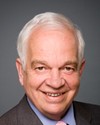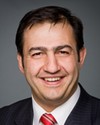Okay.
The second question was the credit and refund aspect on amendment L-18, page 25.
Evidence of meeting #88 for Finance in the 39th Parliament, 1st Session. (The original version is on Parliament’s site, as are the minutes.) The winning word was amendments.
A recording is available from Parliament.
3:55 p.m.
Conservative

The Chair Conservative Brian Pallister
Okay.
The second question was the credit and refund aspect on amendment L-18, page 25.
3:55 p.m.
Director, Tax Legislation Division, Tax Policy Branch, Department of Finance
As I read L-18, it deals with the liability of SIFT trusts for an additional 10% distribution. Then, in addition to the 10% distribution tax, there would be a penalty under the part equal to that distribution tax, and I gather the 10% there is what's being changed from the other provision.
I would like to pose a question, through the chair, to Mr. McCallum. Under the proposals in the bill, the tax that's imposed at the trust level would be creditable through the dividend tax credit mechanism to the beneficiary on the distribution. I'm wondering, are there any amendments in here to fix it so that instead of getting the dividend tax credit that effectively recognizes 31 points of tax, it's been changed to effectively recognize 10 points of tax?
4 p.m.
Liberal

John McCallum Liberal Markham—Unionville, ON
My understanding is that the tax is 10% with no adjustment to dividend tax credit but that the tax is refundable to all Canadian residents. So effectively the tax is only on distributions to non-residents.
4 p.m.
Director, Tax Legislation Division, Tax Policy Branch, Department of Finance
Well, to respond to that question, the way the tax is made refundable to beneficiaries is that the distribution that's made to a Canadian resident and that has been subject to this tax at the trust level is deemed to be a dividend eligible for the dividend tax credit. As a result, they're credited with the dividend tax credit at the individual level.
That's the mechanism for the refund. Unless that mechanism is changed somehow, it will be refunding at a 31% rate, even though, under this proposal, I think the tax would be applied at a 10% rate.
4 p.m.
Liberal

John McCallum Liberal Markham—Unionville, ON
That's why we delete the original clauses 2, 6, 7, 8, and 11. I think that then deals with that problem. Ours is effectively a much simpler situation; it's effectively just a 10% tax on distributions to non-residents.
4 p.m.
Conservative

The Chair Conservative Brian Pallister
Based on these comments, I'm not concerned about the legitimacy of these amendments.
I want you to move to page 23 of your notes. This is in reference to amendment L-17, section 2.1, and I read into the record that:
Every individual who is resident in Canada and liable to pay tax under Part 1 may claim a refund or credit against tax otherwise payable under that Part of an amount designated by the issuer of the security in prescribed form.
Would it be your position that the ability to claim a refund, which is an expenditure--it's a reduction in revenue--makes this particular clause out of order because this would require government spending in addition to the bill? By allowing a refund to be claimed, obviously, that's in essence an expenditure.
4 p.m.
Director, Tax Legislation Division, Tax Policy Branch, Department of Finance
Under the bill as it's formulated, before the amendment, the refund mechanism, in essence, is through the dividend tax credit. The dividend tax credit is a non-refundable credit, and as a result, if an individual were to have insufficient tax to absorb the whole of the dividend tax credit, the person would be entitled to a lesser refund than the full amount of tax paid at the trust level.
If I understand the proposal correctly, in that circumstance, a tax refund would be paid out through the tax system to the investor. That would reduce government revenues, again, not only because of the 10% tax being less than 30%, but also because of the refund being essentially refundable.
I can't say that in either of those circumstances it increases the tax. What it does do is potentially reduce the tax on the one side and potentially increase a refund in circumstances when it might not otherwise be available on the other.
4 p.m.
Conservative
4 p.m.
Conservative

The Chair Conservative Brian Pallister
—to refund it. Yes, he said the credit has a refund mechanism. It puts in place a refund mechanism using money from the consolidated revenue fund, which is not required under the bill. The bill is a non-refundable credit. This is putting in place a refundable credit that requires the additional use of moneys from the consolidated revenue fund, and therefore that particular amendment is not in order.
4 p.m.
Conservative

The Chair Conservative Brian Pallister
I rule that that particular amendment, which is amendment reference 2972723, is not in order.
4 p.m.
Liberal

John McCallum Liberal Markham—Unionville, ON
I think there's one point. The government is better off. The amount refunded is less than the tax collected.
4:05 p.m.
Conservative

The Chair Conservative Brian Pallister
It's a new mechanism for a tax refund, which is not in place in the bill, sir. Therefore, I've already ruled—
4:05 p.m.
Conservative

The Chair Conservative Brian Pallister
Unless you wish to proceed to challenge my ruling, I ruled that that particular amendment is out of order. The other is not.
4:05 p.m.
Liberal

Massimo Pacetti Liberal Saint-Léonard—Saint-Michel, QC
If I may, Mr. Chairman, can we ask Mr. Lalonde to repeat what he just said? I don't want to put words in Mr. McCallum's mouth, but his tax is a refundable tax. So the tax that's going to eventually get refunded is not an expenditure. The tax is just a liability. It's not even necessarily going to be in government revenue. We're actually going from 31% to 0%.
4:05 p.m.
Conservative

The Chair Conservative Brian Pallister
A refundable tax credit is a use of revenue from the consolidated revenue—
4:05 p.m.
Liberal

Massimo Pacetti Liberal Saint-Léonard—Saint-Michel, QC
I would prefer if Mr. Lalonde would repeat his statement in which he said it was an additional tax—
4:05 p.m.
Conservative

The Chair Conservative Brian Pallister
—I cannot allow the discussion to continue on the same ruling, on the same basis. That being the case—
4:05 p.m.
Liberal